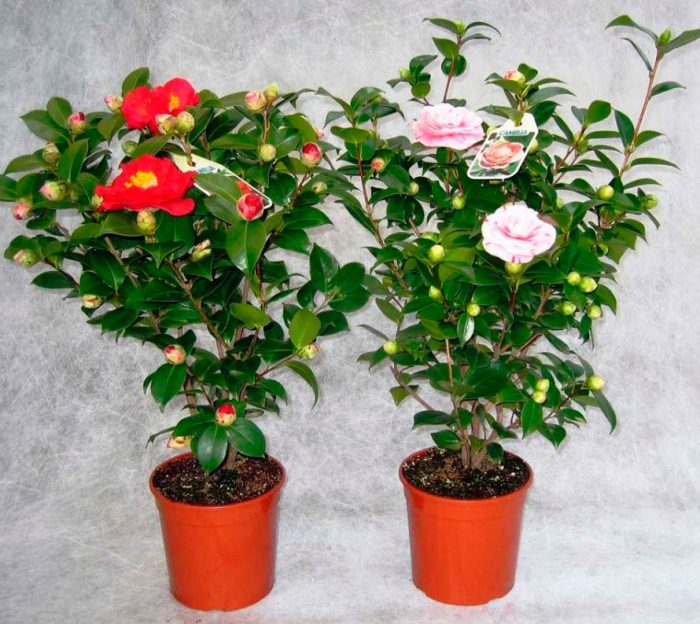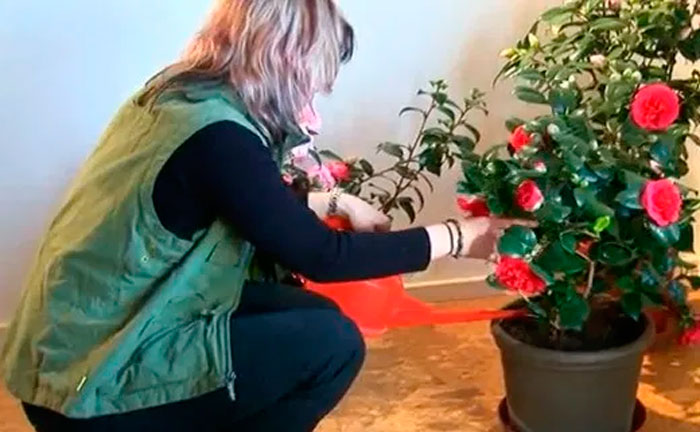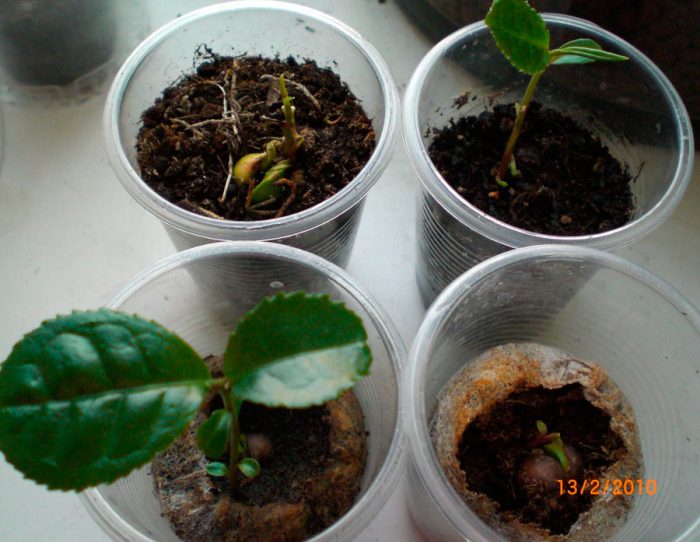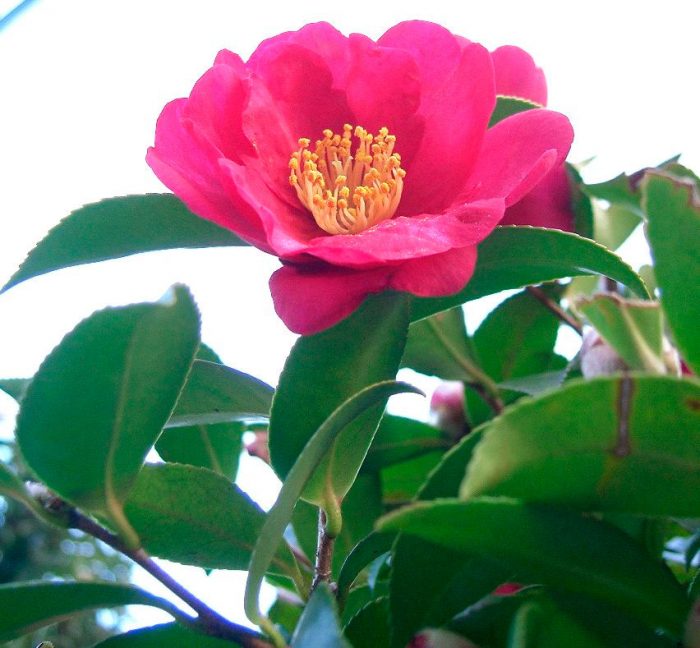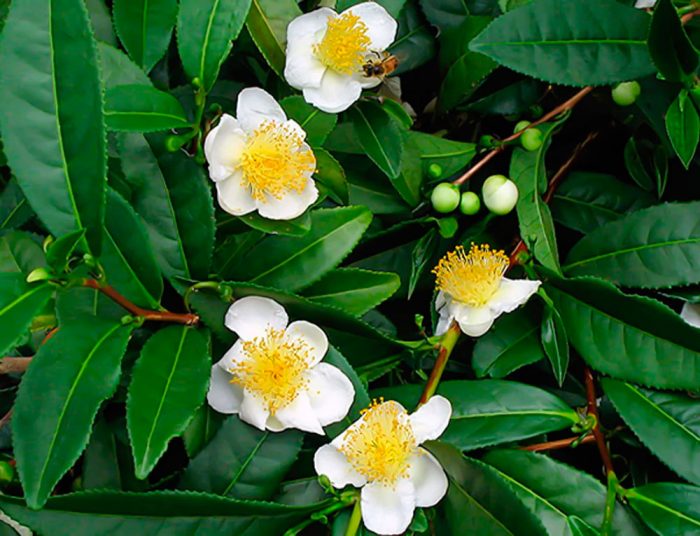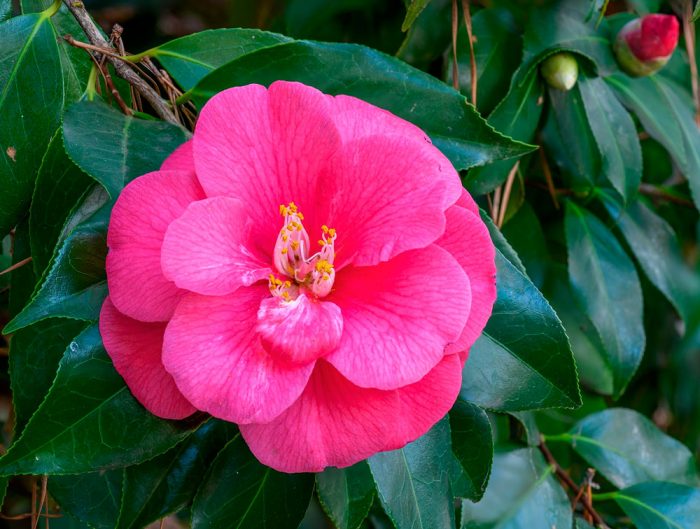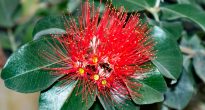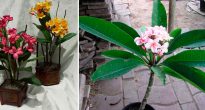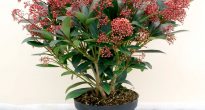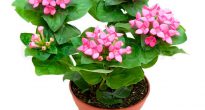Genus camellia (Camellia) is directly related to the tea family. This genus unites about 80 species of various plants. In nature, it is found in tropical and subtropical regions of Southeast and East Asia, in Korea, the Philippines and about. Java, Japan and the Indochina Peninsula. Naturalist and priest G.I.Kamelius was the first to bring these plants from the Philippines to Europe, which were later named after this worthy man.
This genus is represented by fairly compact evergreen shrubs and trees. Simple glossy leaves with an elliptical or ovoid shape, leathery to the touch. There are leaves with both pointed and blunt ends, and they grow separately or in 2 or 3 pieces. The flowers have many stamens and are colored pink, red, white, and there are also variegated forms.
There are very decorative species that have very spectacular flowers and foliage. Camellia at home with good care grows, develops and blooms within normal limits, and it can also bear fruit. Newcomers to floriculture often make a number of care mistakes when growing camellia, for example, the plant happens: there is little light, too hot, there is not enough moisture, or the wrong soil mixture is selected for planting it. And this can lead to the death of the flower.
Home care for camellia
Illumination
Needs bright lighting, but at the same time it should be diffused. Camellia is recommended to be placed on the windows of east or west orientation. If you put it near the south window, you will need shading from the direct rays of the sun, and on the north side - insufficient lighting. In order to form a beautiful bush, the flower pot must be rotated a little regularly around its axis. However, remember that in no case should you do this when buds are formed on the plant, since otherwise the camellia can throw them off. In the summertime, it is recommended to move the plant outdoors and choose a place protected from direct sunlight.
Temperature regime
In the spring and summer, it needs warmth (from 20 to 25 degrees). During the period of bud formation, the temperature must be reduced, so it should be no more than 18 degrees. During the flowering period, which usually lasts from December to February, the plant must be kept at a temperature of 8-12 degrees.With a warmer content, the buds may fall off or the flowers will lose their spectacular appearance. Flower buds can form in a cooler room, but the daylight hours must be short. The room where the camellia is located must be regularly ventilated.
Watering
During the warm season, watering should be abundant, but at the same time, make sure that the liquid does not stagnate in the soil. Watering is carried out only after the top layer of the substrate dries out. For irrigation, use extremely soft and well-settled water. When kept cold in winter, water the plant very carefully. If the soil acidifies as a result of overflow, this will lead to the death of the buds, and the leaves will change color to brown. If the earthen coma is allowed to dry out, then as a result, the camellia will drop all the leaves.
Humidity
Needs high humidity. To increase it, it is recommended to pour a little expanded clay or pebbles into the pan and pour in water. It is also necessary to frequently spray the foliage using exceptionally soft water. When spraying, try to keep the liquid out of the flowers.
Fertilizer
Camellia needs feeding all year round, and it is fertilized once every 3 weeks. To do this, use a solution of a complex mineral fertilizer (1 gram of fertilizer is taken for 1 liter of water).
Pruning
For better growth of axillary buds, the stems of the plant are cut. This procedure is carried out at the end of the autumn period.
Camellia transplant
Young plants need an annual transplant. In the case when the camellia blooms every year, it must be subjected to this procedure less often, namely, once every 2 years. The transplant is carried out in spring and at the same time the stems are pinched to improve branching.
Earth mix
Suitable soil should be acidic pH 4.5-5. Home-grown camellia differs from those in the wild in that it can easily grow in soil, the acidity of which is less than 4. A suitable soil mixture consists of turf, peat and leafy soil, as well as sand, taken in a 1: 2: 2 ratio :1. For those camellias that grow in tubs, it is necessary to fill up the soil with fertilizers annually. Don't forget about good drainage.
Reproduction of camellia
Growing from seeds
Seeds are sown in pots with a diameter of 5 centimeters. Sow seeds, one in each container. After the appearance of 2 true leaves, a pick is made into larger pots. As a rule, camellias grown from seeds do not retain the characteristics of the parent plant; therefore, propagation by cuttings is recommended.
Cuttings
Ornamental varieties are usually propagated by cuttings and do so in July and January. The apical cuttings should not be lignified, but should be 6 to 8 centimeters long. Each of the cuttings should have 3-5 fully developed leaves. Cuttings are planted in boxes and put in a warm place (20-23 degrees). The soil mixture should consist of sand and peat, taken in equal proportions. Rooting in the summer takes place within 8 weeks, and in the winter - this process is longer. Cuttings must be regularly watered and sprayed. To shorten the rooting time, it is recommended to treat the cuttings with heteroauxin before planting. However, this may not affect the rooting process in any way. Rooted cuttings are planted in pots with a diameter of 7 centimeters. To do this, use a soil mixture consisting of leaf, peat and sod land, as well as sand, taken in a ratio of 2: 2: 1: 1. You can graft both rooted cuttings and plants of one or two years of age. At first, watering should be abundant, and then it is reduced so that the petioles lignify faster.
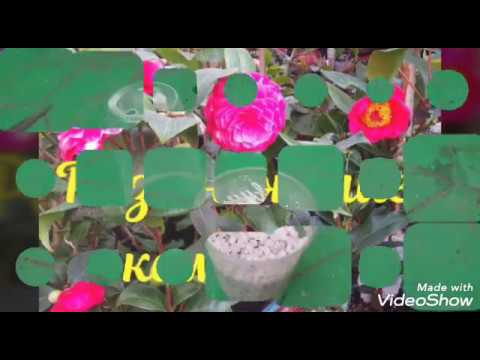

Watch this video on YouTube
Reproduction by grafting
In the case when the cutting takes root very badly, then such a variety of plants is propagated by grafting.This procedure should be carried out in winter in January. For this you need to take well-developed buds from the top of the stem. Then the plant must be kept at an air temperature of 20 degrees. The buds will sprout in 8 weeks. Young plants should be regularly watered, sprayed, and pruned. In no case should they be exposed to direct rays of the sun, as burns will appear on the foliage, and it will fall off. A year later, the camellia will need to be transplanted into pots with a nine-centimeter diameter, filled with the same earth mixture. In the 3rd year of life, the plant must be carefully transferred into pots with a diameter of 11-14 centimeters. They need to be filled with a special soil mixture consisting of turf, peat, leaf and heather soil, as well as sand, taken in a ratio of 2: 2: 2: 2: 1.
Diseases and pests
Can settle spider mite.
Possible problems
- Buds die - this can happen due to overflow, while the leaves will turn brown.
- Falling foliage - when overdrying an earthen coma.
- Brownish spots appeared on the leaves - these are burns from direct sunlight.
- The plant dies - the main reasons are: lack of light, high air temperature, inappropriate soil mixture or too low humidity.


Watch this video on YouTube
Types of camellas with photos
Mountain camellia (Camellia sasanqua)
Or camellia tegmentosa (Camellia tegmentosa) or camellia Miyagii (Camellia miyagii) - in nature, this species is found on the islands of Kyushu and Okinawa. These shrubs are quite tall, so they can reach 3-5 meters in height. On the surface of the stems there is pubescence in the form of reddish hairs, and the branches of this plant are very thin. The leaves are elliptical or elongated-ovoid, up to 7 centimeters long and up to 3 centimeters wide. Their edges are jagged, the glossy front side is painted in a dark green color, the middle vein has pubescence on the seamy side. Simple fragrant flowers can be up to 7 centimeters in diameter. They can be either single or grow in 2 or 3 pieces. Flowers are painted in pink, red or white. Abundant flowering is observed in November – January. These plants prefer coolness.
Chinese Camellia (Camellia sinensis)
Or camellia bohea (Camellia bohea) - naturally found in the forests of China and prefer to grow on mountain slopes or in gorges. This species is represented by both shrubs and trees, reaching a height of 15 meters. The leaves have an elliptical or ovoid shape and grow up to 10 centimeters in length and up to 4 centimeters in width. Glossy leaves are colored dark green. Young leaves have a pubescence of whitish hairs, and old leaves are bare. The axillary flowers are white and have fairly short pedicels. They grow one by one or 2-3 pieces.
Japanese camellia (Camellia japonica)
In nature, this species is found in the forests of China, Japan and Korea. Such shrubs or trees can be up to 15 meters high. Glossy, leathery, dark green leaves are serrated along the edge and are pointed at the top. Their shape is elliptical or ovoid, and the leaves grow up to 10 centimeters in length. Simple flowers reach 4 centimeters in diameter and can grow both singly and in several pieces. There are semi-double and double flowers, and they are painted in a pink, red or white color shade, and there is also a variegated color. Blooms from December to April.
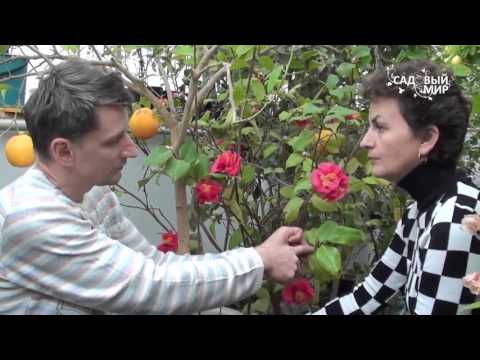

Watch this video on YouTube


